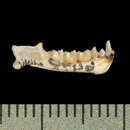en
names in breadcrumbs


Males of this species have chest and throat glands. The echolocation signals are short and are emitted through the mouth. Their enemies include humans, diurnal and nocturnal birds of prey, and parasites. (Grimek, 1990). There is limited information on this particular species of bat.
Perception Channels: tactile ; chemical
The status of the Pocketed Free-tailed Bat is not known. They are undoubtedly being threatened by the habitat modification and pesticide dispersal by humans. (Grzimek, 1990) There are no conservation projects underway specifically for Nyctinomops femorosacca.
Temperate North American bats are now threatened by a fungal disease called “white-nose syndrome.” This disease has devastated eastern North American bat populations at hibernation sites since 2007. The fungus, Geomyces destructans, grows best in cold, humid conditions that are typical of many bat hibernacula. The fungus grows on, and in some cases invades, the bodies of hibernating bats and seems to result in disturbance from hibernation, causing a debilitating loss of important metabolic resources and mass deaths. Mortality rates at some hibernation sites have been as high as 90%. While there are currently no reports of Nyctinomops femorosaccus mortalities as a result of white-nose syndrome, the disease continues to expand its range in North America.
US Federal List: no special status
CITES: no special status
IUCN Red List of Threatened Species: least concern
They are insectivorous and play a part in controlling many of the pesky insects that destroy plants and crops.
This species of bat is strictly insectivorous. Peak activity for feeding occurs at two different times, at the beginning of the night, and again at the end. Like many bats, the Pocketed Free-tailed Bat uses echolocation to detect the presence of its prey. (Grzimek, 1990). They catch their food in mid-flight. They typically eat moths, crickets, flying ants, stinkbugs, froghoppers, and lacewings. (httm://www.nsrl.ttu.edu/tmot/nyctfemo.htm)
Nyctinomops femorosacca, the Pocketed Free-tailed Bat, is a member of the Molossidae. It inhabits the southwestern United States and northwestern Mexico. The bat has been seen in southern Arizona, southern California, southeastern New Mexico, western Texas, and into Mexico to the state of Michoacan. ( http://www.nsrl.ttu.edu/tmot/nyctfemo.htm )
Biogeographic Regions: nearctic (Native )
This species inhabits semiarid desertlands. Their roosts can be found in caves, tunnels, mines, and rock crevices. They have also been found hanging under the roof tiles of buildings. They are usually found in large colonies. (Vaughn, Ryan, Czaplewski, 1999)
Terrestrial Biomes: desert or dune ; chaparral
The Pocketed Free-tailed Bat has a large broad head with grooved lips. The face has many stiff hairs with spoonlike tips. A tragus is present and the ears are thick and leathery. These ears are joined in the middle of the forehead. The length of the bat on average is approximately 112mm. The feet are 10mm, the tail is 46mm, the ears 23mm, and the forearms are 46mm. The nasals are located on the nasal protuberance and no nose leaf is present (Grzimek, 1990). The wings are long and narrow. The tail extends well beyond the edge of the uropatagium. The fur is short. A fold of skin stretches from the inner side of the femur to the middle of the tibia. Ths fold produces a pocket on the underside of the interfemoral membrane, which gives the animal its common name, the Pocketed Free-tailed Bat. The dental formula is 1/2, 1/1, 2/2, 3/3=30, with the incisors placed close together. ( http://www.nsrl.ttu.edu/tmot/nyctfemo.htm )
Range mass: 10 to 14 g.
Other Physical Features: endothermic ; bilateral symmetry
Females bear a single embryo. Young are born to the female in late June to early July. The gestation period is about 70 to 90 days. When young are born, they weigh 3-4 grams, or about 22% of the adult weight. (Grzimek, 1990) Data on the reproduction of this species is scarce.
Key Reproductive Features: gonochoric/gonochoristic/dioecious (sexes separate); sexual